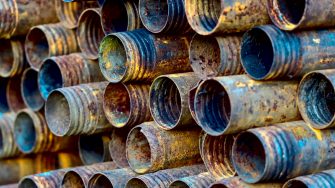
There are several types of corrosion, including wet corrosion and dry corrosion.
Dry corrosion occurs when there is no water or moisture to aid the corrosion, and the metal oxidises with the atmosphere alone.
Wet corrosion of metals occurs through electron transfer, involving two processes, oxidation and reduction. In oxidation, the metal atoms lose electrons. The surrounding environment then gains the electrons in reduction. The metal, where electrons are lost, is called the anode. The other metal, liquid or gas which gains the electrons is called the cathode.
Corrosive environments
As mentioned previously, most corrosion is the formation of metal oxides. This means that any metal (with the exception of gold) will oxidise in any environment that contains oxygen.
Air contains, on average, 21% oxygen, 78% nitrogen, and 1% argon. It can also contain water vapour, ozone, and carbon dioxide.
Water is very commonly aerated which again means there is oxygen for reaction with metals.
There are many factors that dictate how corrosive an environment is. One is the amount of oxygen available to form corrosion products or the presence of water or moisture which greatly accelerate the rate of corrosion. Another is the presence of other elements, ions and compounds that can limit or enhance corrosion rates. Therefore corrosion rates are often considered in different atmospheres: industrial, rural and marine. Each of these environments will contain different amounts of oxygen and other “pollutants” like ozone, salt, dusts, sulphur dioxide, ammonia, hydrogen and hydrogen sulphide.
